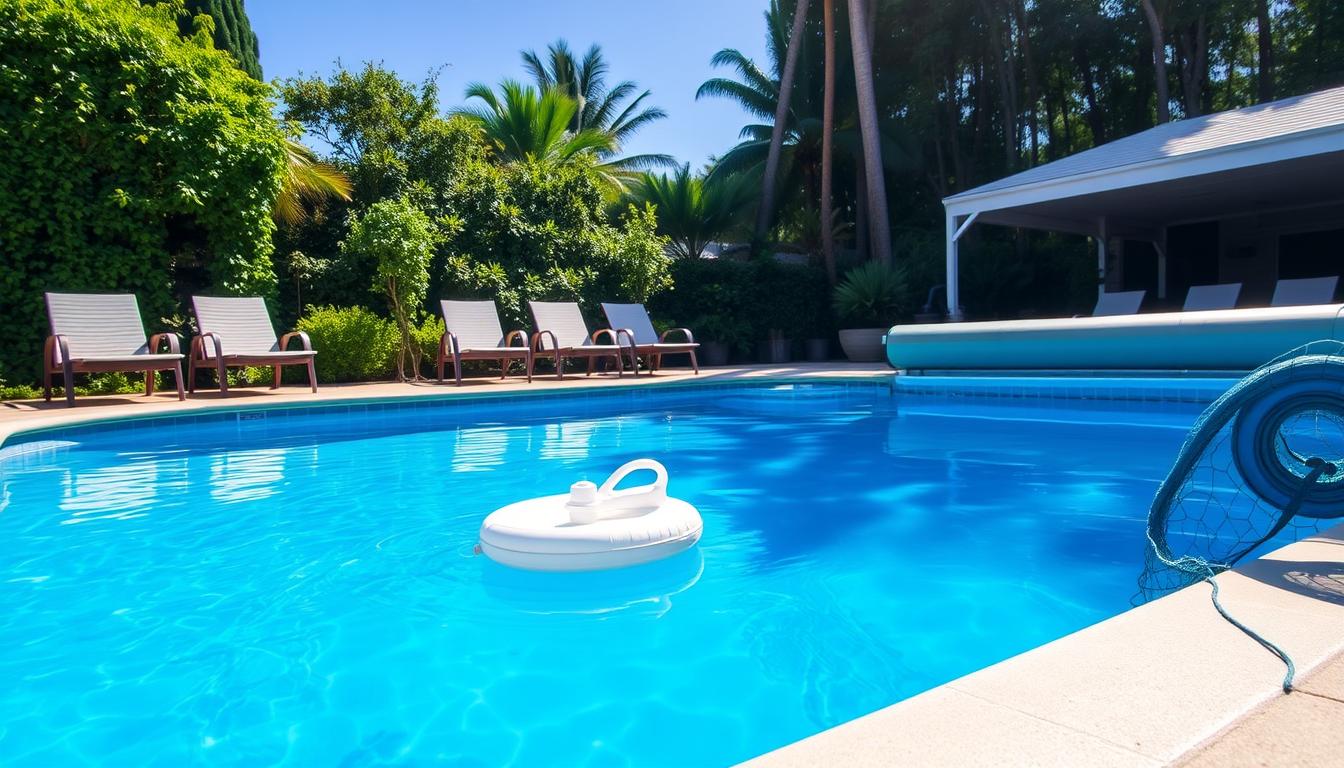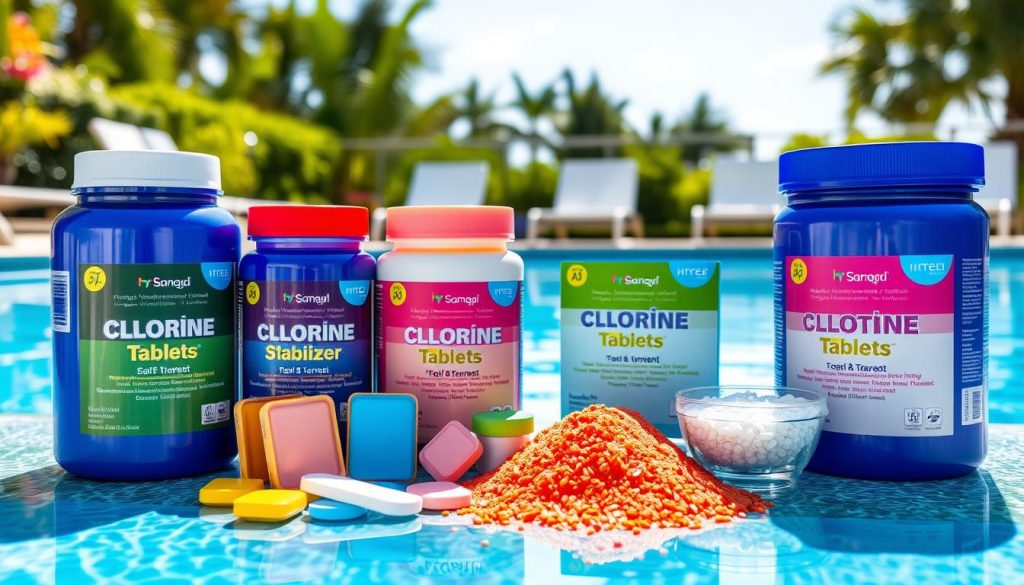
Pools need chlorine levels between 1.0 and 3.0 parts per million (ppm). This balance ensures safe and fun swimming. Many factors can affect chlorine effectiveness, including swimmers, circulation, pH levels, and sunlight.
We’ll explore strategies for maintaining optimal chlorine levels. Regular monitoring and balancing pool chemicals help keep your pool pristine.
Proper chlorine levels prevent harmful bacteria and algae growth. Low levels lead to cloudy water, bad smells, and health risks. High levels cause skin irritation and damage pool equipment.
Understanding ideal chlorine ranges helps create a safe pool environment. Effective strategies for maintaining chlorine levels ensure enjoyable swimming for everyone.
Key Takeaways
- Maintain chlorine levels between 1.0 and 3.0 ppm for optimal pool health
- Regular testing and adjustment of pH, alkalinity, and chlorine levels is crucial
- Factors such as swimmer load, circulation, and sunlight can affect chlorine effectiveness
- Utilizing chlorine stabilizers and proper pool maintenance can help maintain stable chlorine levels
- Consult with pool care professionals for personalized advice and solutions
Maintaining Proper Chlorine Levels
Proper chlorine levels are vital for a safe and enjoyable swimming experience. The right balance keeps water clean and free from harmful bacteria. Let’s explore how to maintain ideal chlorine levels in your pool.
Ideal Chlorine Range
The recommended chlorine range for pools is 2 to 4 parts per million (ppm). This level effectively neutralizes contaminants while remaining safe for swimmers. The minimum level is 1 ppm, and the maximum is 6 ppm.
Testing Chlorine Levels Regularly
Regular testing ensures chlorine levels stay within the ideal range. Test strips offer a quick and easy method. Simply dip the strip in pool water and compare colors.
Test kits provide more accurate readings but require more time and effort. Both methods help maintain proper chlorine levels in your pool.
| Chlorine Level | Ideal Range (ppm) | Minimum (ppm) | Maximum (ppm) |
|---|---|---|---|
| Free Chlorine | 2.0 – 4.0 | 1.0 | 6.0 |
| Combined Chlorine | < 0.2 | – | 0.5 |
| Total Chlorine | Equal to Free Chlorine | – | – |
Adjusting Chlorinator Output
For saltwater pools, adjust the chlorinator output to maintain proper levels. Chlorinators work best with salt levels around 5000 ppm. Low salt can lead to low chlorine output.
Run the pump and chlorinator at night to save energy. This helps minimize chlorine demand when UV rays are absent. During heavy use or hot days, run the pump during daytime.
“Regularly testing and adjusting your pool’s chlorine levels is the key to maintaining a safe and inviting swimming environment for your family and friends.”
Keeping chlorine levels ideal, testing regularly, and adjusting output ensures a clean, clear pool. Your swimming season will be enjoyable and worry-free with proper maintenance.
Utilizing Chlorine Stabilizers
Chlorine stabilizers are crucial for maintaining proper chlorine levels in pools. They protect chlorine from the sun’s UV rays, keeping it active longer. Using stabilizer-containing chlorine tablets or liquid chlorine ensures consistent sanitization.
These stabilizers, also known as cyanuric acid, act like sunscreen for chlorine. They help us save money on chemicals and reduce the need for pool shocking.

Cyanuric Acid: UV Blockout
Cyanuric acid shields chlorine from UV rays. It binds with chlorine molecules, creating a protective barrier. This process keeps chlorine active for longer periods.
Optimal Stabilizer Levels
Balancing chlorine stabilizers is vital for a clean pool. Outdoor chlorine pools need 30-70 ppm of cyanuric acid. Saltwater pools require 50-70 ppm.
Be careful not to over-stabilize, as it can reduce chlorine effectiveness. Maintaining the right balance is key to pool health.
| Type of Stabilizer | Description |
|---|---|
| Stabilized Chlorine | Chlorine products that already contain cyanuric acid, such as trichlor or dichlor tablets |
| Liquid Stabilizer | A concentrated liquid form of cyanuric acid that can be added directly to the pool water |
| Powder Stabilizer | A granular form of cyanuric acid that can be mixed with water and added to the pool |
Monitoring and Balancing Cyanuric Acid
Cyanuric acid stays in pool water. It only decreases when water is removed through splashing, draining, or backwashing. Usually, we only add stabilizer once per season when opening the pool.
If the pool loses water during the season, we might need to add more stabilizer. Regular testing of chlorine and cyanuric acid levels is essential.
It’s essential to regularly test our pool water for both chlorine and cyanuric acid levels to ensure a healthy and safe swimming environment. If cyanuric acid levels exceed the recommended range, we can use a cyanuric acid reducer or partially drain and refill the pool to bring the levels back down.
Proper use of chlorine stabilizers creates an efficient pool maintenance routine. This keeps our pool clean, clear, and enjoyable all summer long.
How to Keep Chlorine in Pool Effectively
Maintaining chlorine levels is crucial for a clean pool. This requires stabilizers, regular testing, and proper chlorine generator settings. Adding salt to our pool helps the chlorinator produce chlorine effectively.
Running the pump at night saves energy and keeps chemicals in the pool. During hot weather or heavy use, increase chlorinator output and run the pump during the day. An energy-efficient variable speed pump can help save costs.
Clean salt water cells regularly for maximum efficiency. Monitor chlorine levels often and adjust as needed. The ideal chlorine range is 1-3ppm.
These steps will keep your pool safe and inviting. Your family and friends can enjoy a well-balanced pool all season long.







